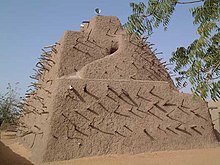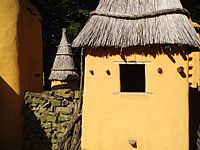
The Songhai Empire was a state located in the western part of the Sahel during the 15th and 16th centuries. At its peak, it was one of the largest African empires in history. The state is known by its historiographical name, derived from its largest ethnic group and ruling elite, the Songhai people. Sonni Ali established Gao as the empire's capital, although a Songhai state had existed in and around Gao since the 11th century. Other important cities in the kingdom were Timbuktu and Djenné, where urban-centred trade flourished; they were conquered in 1468 and 1475, respectively. Initially, the Songhai Empire was ruled by the Sonni dynasty, but it was later replaced by the Askia dynasty (1493–1591).
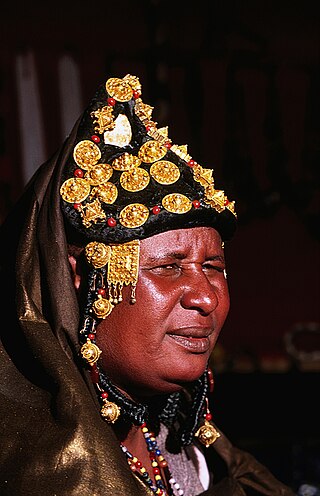
The Songhai people are an ethnolinguistic group in West Africa who speak the various Songhai languages. Their history and lingua franca is linked to the Songhai Empire which dominated the western Sahel in the 15th and 16th century. Predominantly adherents of Islam, the Songhai are primarily located in Niger and Mali. Historically, the term "Songhai" did not denote an ethnic or linguistic identity but referred to the ruling caste of the Songhay Empire known as the Songhaiborai. However, the correct term used to refer to this group of people collectively by the natives is "Ayneha". Although some speakers in Mali have also adopted the name Songhay as an ethnic designation, other Songhay-speaking groups identify themselves by other ethnic terms such as Zarma or Isawaghen. The dialect of Koyraboro Senni spoken in Gao is unintelligible to speakers of the Zarma dialect of Niger, according to at least one report. The Songhay languages are commonly taken to be Nilo-Saharan but this classification remains controversial: Dimmendaal (2008) believes that for now it is best considered an independent language family.

Sudano-Sahelian architecture refers to a range of similar indigenous architectural styles common to the African peoples of the Sahel and Sudanian grassland (geographical) regions of West Africa, south of the Sahara, but north of the fertile forest regions of the coast.

Askia Muhammad Ture I (1443–1538), born Muhammad ibn Abi Bakr al-Turi or Muhammad Ture, was the first ruler of the Askia dynasty of the Songhai Empire, reigning from 1493 to 1528. He is also known as Askia the Great, and his name in modern Songhai is Mamar Kassey. Askia Muhammad strengthened his empire and made it the largest empire in West Africa's history. At its peak under his reign, the Songhai Empire encompassed the Hausa states as far as Kano and much of the territory that had belonged to the Songhai empire in the east. His policies resulted in a rapid expansion of trade with Europe and Asia, the creation of many schools, and the establishment of Islam as an integral part of the empire.

Gao, or Gawgaw/Kawkaw, is a city in Mali and the capital of the Gao Region. The city is located on the River Niger, 320 km (200 mi) east-southeast of Timbuktu on the left bank at the junction with the Tilemsi valley.

Sankoré Madrasa is one of three medieval mosques and centres of learning located in Timbuktu, Mali, the others being the Djinguereber and Sidi Yahya mosques. Founded in the 14th century, the Sankoré mosque went through multiple periods of patronage and renovation under both the Mali Empire and the Songhai Empire until its decline following the Battle of Tondibi in 1591. The mosque developed into a madrasa, reaching its peak in the 16th century.

The Tomb of Askia, in Gao, Mali, is believed to be the burial place of Askia Mohammad I, one of the Songhai Empire's most prolific emperors. It was built at the end of the fifteenth century and is designated as a UNESCO World Heritage Site.
Askia Mohammad Benkan, also Askiya Muhammad Bonkana Kirya, was the third ruler of the Songhai Empire from 1531 to 1537.
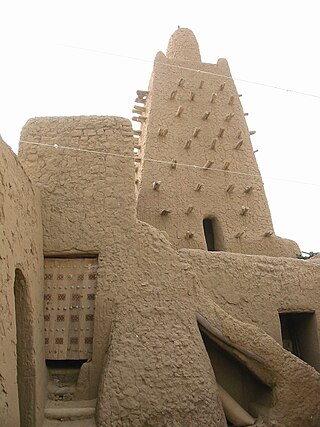
The Djinguereber Mosque, also known as Djingareyber or Djingarey Ber, is a famous learning center in Timbuktu, Mali. Built in 1327, it is one of three madrassas composing the University of Timbuktu. It was inscribed on the list of UNESCO World Heritage Sites in 1988.

The Sidi Yahya Mosque, also known as the Mosque of Muhammad-n-Allah, is a mosque and madrasa of Timbuktu in Mali. The construction of the mosque began in 1400 under the leadership of Sheikh el-Mokhtar Hamalla of Timbuktu and was finished in 1440.

The Zarma people are an ethnic group predominantly found in westernmost Niger. They are also found in significant numbers in the adjacent areas of Nigeria and Benin, along with smaller numbers in Burkina Faso, Ivory Coast, Ghana, Togo, and Sudan. In Niger, the Zarma are often considered by outsiders to be of the same ethnicity as the neighboring Songhaiborai, although the two groups claim differences, having different histories and speaking different dialects. They are sometimes lumped together as the Zarma-Songhay or Songhay-Zarma.
The Dendi was a former province of the Songhai Empire. It survived the fall of the Empire as a kingdom until 1901, when it was conquered by France and incorporated into French West Africa. Its centers today are the cities of Gaya in Niger, Kamba in Nigeria and Malanville in Benin.
The Gao Empire was a kingdom that ruled the Niger bend from approximately the 7th century CE until their fall to the Mali Empire in the late 14th century. Ruled by the Za dynasty from the capital of Gao, the empire was an important predecessor of the Songhai Empire.
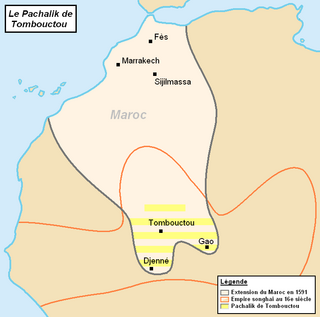
The Pashalik of Timbuktu, also known as the Pashalik of Sudan, was a West African political entity that existed between the 16th and the 19th century. It was formed after the Battle of Tondibi, when a military expedition sent by Saadian sultan Ahmad al-Mansur of Morocco defeated the Songhai Empire and established control over a territory centered on Timbuktu. Following the decline of the Saadi Sultanate in the early 17th century, Morocco retained only nominal control of the Pashalik.

The architecture of Mali is a distinct subset of Sudano-Sahelian architecture indigenous to West Africa. It comprises adobe buildings such as the Great Mosque of Djenné or the University of Timbuktu. It can be found all over the Sahel region of Africa. Malian architecture developed during the Ghana Empire, which founded most of Mali's great cities. They then flourished in West Africa's two greatest civilisations the Mali Empire and the Songhai Empire.
Askia Daoud was the ruler of the Songhai Empire from 1549 to 1582. His rule saw the empire rise to a peak of peace and prosperity following a series of succession disputes and short reigns.

The Songhaiborai are a distinct subgroup within the larger Songhai ethnolinguistic family. Residing predominantly in Niger's Songhai region, Northern Mali, and a minority presence in Burkina Faso. Notably, they trace their lineage to the ruling dynasties of the ancient Songhai Empire.
The Sohance are a social caste among the Songhai nobility. They are believed to be the direct descendants of the Sonni Dynasty and its last ruler, Sonni Ali Ber, the founder of the Songhai Empire, who reigned from 1464 to 1492.
Mali, located in West Africa, is a country rich in history, culture, and architectural heritage. From ancient mosques to stunning natural landscapes, Mali boasts a diverse array of landmarks that showcase its significance in the region and the world.
Mahmud ibn Zarkun, also known as Mahmud ben Zergun, was a Moroccan eunuch who rose to the rank of pasha. For a time, he served as the commander of all renegades in Morocco. He succeeded Judar Pasha as the main commander of the Moroccan invasion of the Songhai Empire from 1591 to 1595. During the battle of Bamba, he defeated Askia Ishaq II and later killed his successor, Askia Muhammad Gao, through a deceitful trap. He continued fighting against Askia Nuh, who succeeded Muhammad. Mahmud was responsible for the repression and plunder of Timbuktu and gradually gained independence from the Sultan of Morocco. Ahmad al-Mansur condemned him to death, but before the executioner could carry out the sentence, Mahmud died in a suicidal battle against the Songhai forces on 15 March 1595 near the Niger River.










